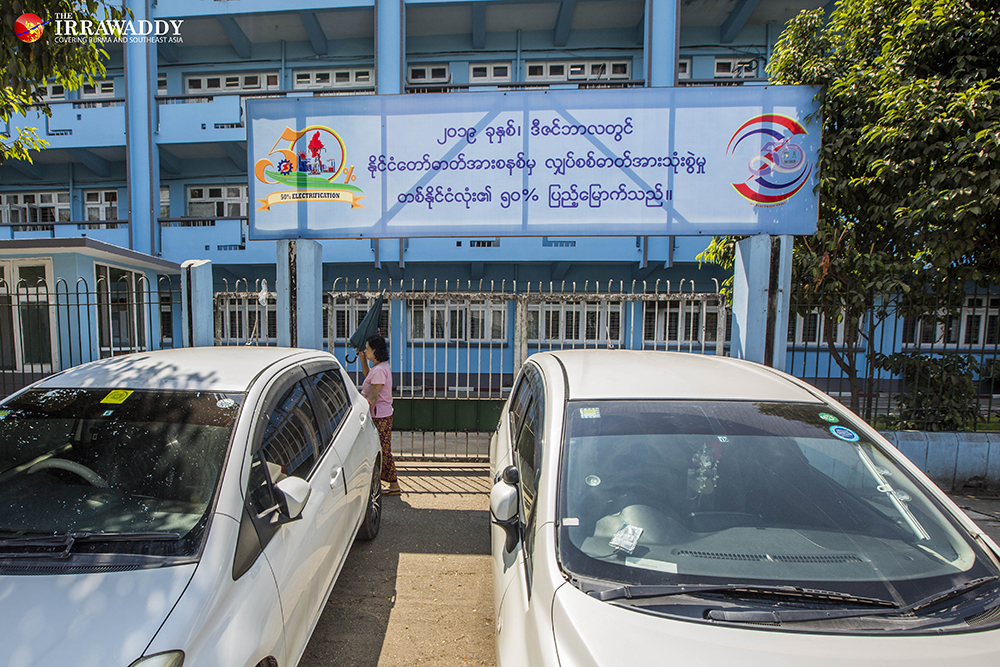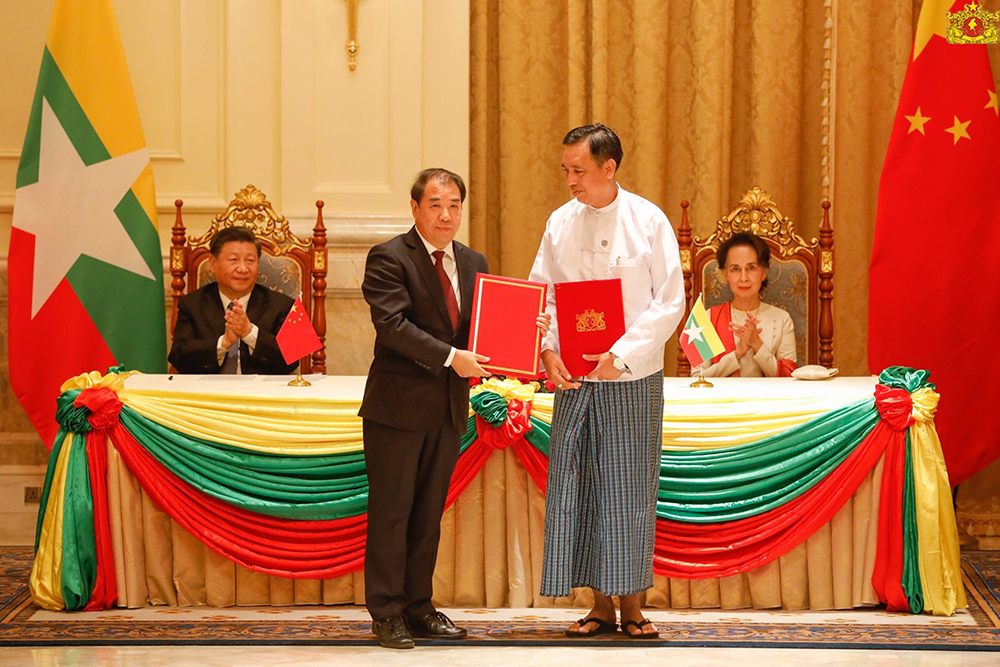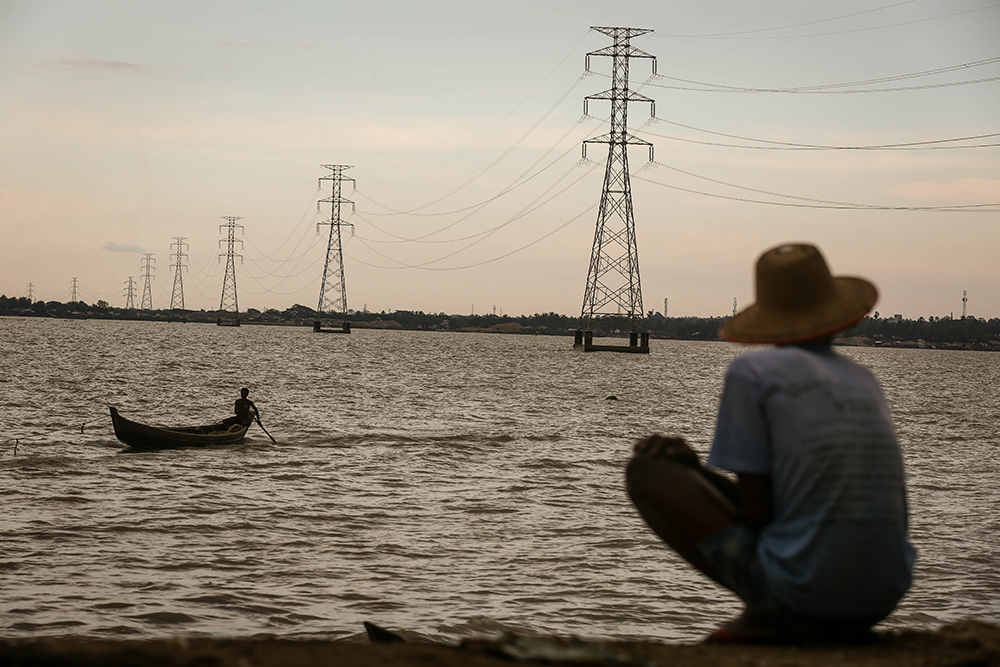YANGON—For much of the past decade, China viewed Myanmar as a potential source of electricity, which it planned to tap through large-scale hydropower projects on the country’s extensive river networks.
But the situation has changed, as China’s massive efforts to develop hydropower have left it with a surplus of power. During the last two years, China’s hydropower plants produced a surplus of nearly 70 billion kilowatt hours (kWh), most of that coming from southwest China’s Yunnan province.
Myanmar has the lowest access to electricity in ASEAN; only half of the country’s 54.5 million population is connected to the national gird. To make matters worse, the country has been struggling with annual blackouts, especially in summer, as most power generation comes from hydropower.
The World Bank warned Myanmar last year that it needs to invest up to US$2 billion (about 2.8 trillion kyats) annually in its electricity sector to sustain economic growth, as electricity consumption is expected to increase by 11 percent yearly until 2030.
The bank predicts Myanmar’s electricity demand will reach 8,600 megawatts (MW) in 2025, and 12,600 MW in 2030, while current electricity production is just 3,600 MW. The Ministry of Electricity and Energy (MOEE) said electricity consumption has increased by 15-19 percent annually over the past few years.
With Myanmar facing a massive power shortfall amid growing domestic demand, its giant neighbor to the north is set to become its major electricity supplier, due to its lower prices, among other conditions and terms.
From Rakhine State in the country’s west to Kachin in the north, planning or construction of power projects backed by mammoth Chinese state-owned enterprises (SOEs) is underway in at least seven states and regions. The projects are expected to raise Myanmar’s electricity generation capacity by at least 3,500 MW—doubling the current capacity—within one to three years. This would be made possible by cross-border power grids from Yunnan, as well as natural gas- and liquid natural gas-fired power plants.
With the rise of Chinese investment in Myanmar’s electricity sector, questions abound regarding China’s eagerness to offer power so cheaply. Some put it more bluntly: Is China trying to influence the future of Myanmar’s power sector?
China observers in the country agree that the investments are part of China’s strategic vision for Myanmar under its Belt and Road Initiative (BRI).
Under the BRI, Myanmar and China have agreed to implement nearly a dozen backbone projects ranging from deep seaports, industrial zones and border economic cooperation zones to a new city.
U Khine Win, the executive director of the Sandhi Governance Institute, said China’s sale of electricity to Myanmar is motivated by self-interest.
“Electricity is very crucial to implementing China’s strategic mega-infrastructure projects in Myanmar. Likewise, selling electricity could also solve China’s power surplus issue,” he said.

Cross-border grids feed power-hungry Myanmar
During Chinese President Xi Jinping’s trip to Myanmar in mid-January, the two sides signed 33 agreements, including two agreements related to a power-supply project; a memorandum of understanding (MOU) on conducting a feasibility study for the Myanmar-China Power Interconnection project, and a letter of intent on the acceleration of the Meel-Lin-Gyaing Integrated LNG project.
Also, an agreement to study Myanmar-China cross-border interconnection projects was signed between the MOEE and China Southern Power Grid (CSG), a Chinese state-owned enterprise (SOE).
The Myanmar government announced in mid-2019 that it will buy 1,000 MW of electricity from the CSG to cover its shortfall. The MOEE said the electricity is expected to be transmitted from Dhong Dai in Yunnan, China, to Muse, Mineye and Hopong in northern Shan State, Loikaw in Kayah State and Phayakyi in Bago Region.
“As electricity demand is rising in the country, we have a target to link the Chinese and Myanmar grids in 2021-22,” U Soe Myint, the deputy permanent secretary of the MOEE, told The Irrawaddy.
The government and company agreed to pay in kyats for the power and detailed negotiations are ongoing. U Soe Myint declined to provide details of the agreement price, saying China has generally agreed to sell electricity at a price that is affordable for Myanmar.
CSG is no stranger to Myanmar. The company has been lobbying to sell electricity to Myanmar since 2014.
CSG is not alone. Other giant Chinese power SOEs including State Grid Corporation of China (SGCC), China Energy Engineering Group (CEEG), Union Resources and Engineering Company (UREC) and Powerchina have been taking steps to sell electricity to power-hungry Myanmar since 2016.
Another cross-border grid, according to the Netherlands-based Transitional Institute (TNI)’s research, runs through Bhamo in northern Kachin State.
The Bhamo route is nearly ready to go online. The 230KV transmission will come from China’s national grid in Yunnan to Bhamo in Kachin State and Ohntaw in Sagaing Region, where it will be connected to Myanmar’s national grid. TNI said Bhamo has already been linked to China’s national grid in Yunnan via the Daepin Dam in Kachin State.
On Jan. 11, SGCC announced that its subsidiary China Electric Power Equipment and Technology Co Ltd (CET) had completed the Nabar-Shwebo-Ohntaw power transmission line and a substation project in Shwebo in Sagaing Region. The grid will pass through Nabar and Shwebo before reaching Ohntaw.
A press release in 2017 from the Chinese Ministry of Foreign Affairs referred to the Bhamo route as a “Backbone Network Power Transmission Project,” saying that while the Nabar-Shwebo-Ohntaw power project will be implemented by SGCC, a transmission line from Nabar to Bhamo would be built by UREC.
Myanmar officially became a BRI partner country after signing a 15-point MoU establishing the China-Myanmar Economic Corridor (CMEC) in September 2018. The two countries agreed to join hands to promote several sectors including collaboration on the power sector.
Investing in energy projects has always been a crucial part of the BRI mega-infrastructure plan. A study by Chinese government-backed Global Energy Interconnection Development and Cooperation Organization (GEIDOC) on BRI energy interconnection published during the 2nd BRI forum revealed that energy investments in BRI countries would total $27 trillion by 2050, with $7 trillion alone going to power grid construction.
The research revealed Beijing’s grand plan to implement interconnection projects between China, Bangladesh, India and Myanmar. It recommended that cross-border interconnection be enhanced to solve power shortages in Bangladesh, India and Myanmar and that hydro, solar and wind power be developed in each country to increase electricity accessibility.
Daw Khin Khin Kyaw Kyee, the head of the China desk at the Institute for Strategy and Policy—Myanmar, told The Irrawaddy that while others criticized Myanmar for its infrastructure weakness, China arrived with its own packages, such as long-term plans to sell electricity to Myanmar.
“They know that electricity is important for the implementation of their projects. Chinese investment came with a long-term vision; they are well-prepared for it,” she said.

LNG, natural gas projects
Since taking office in 2016, the NLD government has shifted its attention from big hydropower projects to liquefied natural gas (LNG) and smaller dams as an alternative solution to tackle the country’s power shortage, as LNG plants can be built faster. Aside from that, hydropower can be unreliable at times—particularly during the dry season, according to the government’s Myanmar National Electrification Plan.
Myanmar is unable to produce LNG on its own since it is very expensive and requires advanced technology; hence most of the investment in energy infrastructure is likely to be borne by investors.
Union Electricity and Energy Minister U Win Khaing said last year that Myanmar will implement gas and LNG power projects to fulfill the county’s demand, as the power requirement is increasing by about 1,000 MW every year.
The minister said the government would call tenders for both short- and long-term projects to meet the increasing power demand in the future.
This is where Chinese companies come in.
According to the Directorate of Investment and Company Administration (DICA), from 2016 to February 2020 the Myanmar Investment Commission approved about 19 electricity supply projects, among them nine projects to be developed by Chinese SOEs and their joint ventures.
In June last year, the MOEE called tenders for two gas plants and three liquefied natural gas (LNG) plants that will produce a total of 1,040 MW to cover expected shortfalls during the summer of 2020.
A consortium of Chinese SOEs and closely allied companies won the contracts to construct the projects, which are worth upwards of a billion dollars.
However, the tender process was criticized by international power companies, who cast doubt on the commercial viability of the five-year concession period, seven-month construction period and fixed tariff paid in kyats.
According to an MOEE statement, the winners were chosen because they offered the lowest unit price.
U Soe Myint declined to reveal the unit price, saying, “It is confidential.”
Of the five projects, Hong Kong-listed Vpower and its joint venture CNTIC were awarded three LNG projects in Thaketa and Thanlyin townships in Yangon and Kyaukphyu in western Rakhine State, where China is developing a Special Economic Zone and a deep seaport under its BRI agreement with Myanmar, aimed at giving China greater leverage in the Indian Ocean. The total power generation of the three LNG projects is 900 MW, at a cost of over US$800 million.
The other two are a consortium led by Vpower, which will implement a 20.54-MW gas power plant at Kyun Chaung in upper Myanmar’s Magwe Region, and a consortium of China Energy Engineering Group-Hunan Electric Power Design Institute Co. Ltd (CEEC-PHEDI), China ITS (Holding) Co. Ltd, and Shenzhen Shennan Power Gas Turbine Engineering Technique Co., which will build a 151.54 MW gas power plant in Yangon’s Ahlone Township. However, one week after MOEE awarded a letter of acceptance (LOA) to the latter, the World Bank debarred CEEC-PHEDI from its financed projects for 20 months for committing fraud in Zambia.
Unusual tender rules
According to the MOEE’s tender rules and regulations for the above LNG and gas power projects, the winners are supposed to finish construction of the plants within seven months. Otherwise, they have to pay 300 million kyats per day as a fine. The concession period is five years from the commercial operation date.
For observers like U Khine Win of Sandhi Institute of Governance, the tender’s terms and conditions are impractical and leave him wondering why the Chinese companies took the risk.
“Those projects are unlikely to be commercially viable. The construction period is too short and the commercial operation date [fine] makes it very hard to get a proper profit for investors,” he said.
The biggest question is why Chinese companies are grabbing this chance.
“It makes it possible for them to gain a foothold in Myanmar’s power sector,” U Khine Win said.
The link between Vpower, Chinese state firm
Of the five tenders mentioned above, Vpower and its affiliates won four.
Although Vpower is a Hong Kong-listed company, it has strong partnerships with Chinese state-owned companies, particularly CNTIC, CRRC—one of the world’s largest manufacturers of railway carriages—and real estate firms based in Beijing.
CNTIC, Vpower’s joint venture for three LNG projects in Myanmar, is a subsidiary of China General Technology Group Holding Ltd. based in Beijing, one of the largest state-owned Chinese conglomerates, investing in activities from machinery manufacturing and pharmaceuticals to technical consulting
According to the company’s website, the co-founder of Vpower, Lee Chong Man Jason, said the company’s cooperation with CRRC and CNTIC on the BRI projects positions Vpower to benefit from growth in power infrastructure development in BRI countries. Furthermore, the Kyaukphyu SEZ developer, China International Trust Investment Corporation (CITIC), holds an 8-percent stake in Vpower.

Crucial power projects under the BRI
Not every power project is officially part of the BRI. However, a 135 MW power plant project in the Kyaukphyu SEZ in western Rakhine State is recognized as an important project for the CMEC. The $180-million project will be developed by Kyauk Phyu Electric Power Co. Ltd, a joint venture between Chinese state-owned firm Power China and Myanmar’s Supreme Group.
The plant is expected to supply an estimated at 1,005 million units annually to Rakhine State and the national grid in 2021. The companies signed power purchasing agreement negotiations with Minister U Win Khaing on the sidelines of the BRI forum in Beijing in late April.
Supreme Group deputy chief executive officer U Htu Htu Aung told The Irrawaddy the government and company agreed to pay in kyats for the power generated. However, both sides declined to provide details of the agreement price, saying only that it is reasonable compared with other gas companies.
Another important project is the Mee Lin Gyaing LNG power plant in Ayeyarwady Region. Worth $2.5-billion, it is the biggest in the Myanmar power sector.
During the Chinese president’s trip to Myanmar in late January, the two sides signed a letter of intent to speed up implementation of the 1,390 MW project, which is to be developed jointly by Yunnan Provincial Energy Investment Group Co Ltd, UREC, Zhefu Holding Group Co Ltd and Supreme Group. The project is expected to be complete in 2023; 35 percent of the power produced will be distributed to Ayeyarwady Region, with the rest going to Yangon via the national grid.
“The agreement for Mee Lin Gyaing is also being finalized. We will make the deal to complete the project during our target period,” U Soe Myint said.
Dependency risk
Compared to locally generated electricity, foreign sourced power seems more vulnerable.
While the connection to the Chinese electricity grid will help cover some of Myanmar’s electricity needs, dependence on foreign electricity sources is always a risk because the supply could be stopped by the corporation or the Chinese government, according to TNI.
Stephanie Olinga-Shannon of the TNI told The Irrawaddy that SGCC—a Chinese company responsible for the Sagaing Region transmission line for the Bhamo route cross-border grid—is a for-profit corporation, meaning it could raise the price of electricity or cease supply to Myanmar if it was not profitable
“The greater the dependency on foreign sources of electricity, the less control and bargaining power the Myanmar government would have in ensuring electricity supply at a fair price,” said the planning and evaluation coordinator cum Chinese foreign policy researcher for the organization.
Furthermore, the infrastructure connecting the two grids will need to cross conflict areas in northern Myanmar, where ethnic armed groups and the Myanmar army are battling each other. This high-cost infrastructure could be a target for sabotage, and investors will likely want to protect their investment.
“This could further militarize these areas, which could further increase the conflict there,” said Olinga-Shannon.
Adding to the risk, the growing Chinese investment in Myanmar’s power sector could make investors from other countries jittery, as it could leave them feeling insecure, said Daw Khin Khin Kyaw Kyee from the Institute for Strategy and Policy—Myanmar.
“When it comes to Chinese investment, especially in the power sector, there is a perception of insecurity among the other investors; for example, what if they shut down the power?” she said, before adding, “This perception could hinder foreign investment in Myanmar.”
Recently, Philippine senators called for an investigation into the security implications of China’s ownership of their country’s energy grid, after an official admitted that engineers in Beijing could plunge the whole of the Philippines into darkness.
Furthermore, Daw Khin Khin Kyaw Kyee said, relying too much on China for power would give it leverage over Myanmar.
“[As a result] China will have bargaining power over Myanmar,” she warned.
















